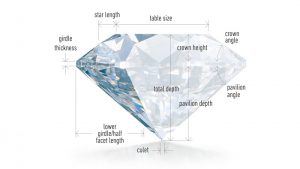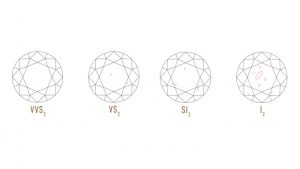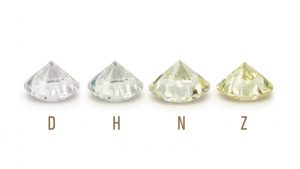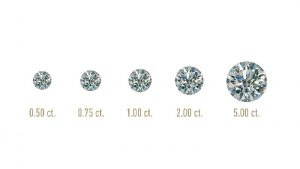A Diamond’s Four C’s
A Diamond’s Four C’s
When shopping for diamond jewelry, particularly your wedding and engagement rings, you need to consider four primary factors, also referred to as A Diamond’s Four C’s: Cut, Clarity, Color, and Carat. Developed by the Gemological Institute of America (GIA), the 4 ‘C’s create a universal method for determining the quality of any piece of diamond jewelry.
A Diamond’s Four ‘C’s: Cut
Diamonds are renowned as the world’s most beautiful gem because of their ability to refract light in a way that no other stone can. This ‘C’ doesn’t necessarily deal with what shape the stone is, but rather how well the facets inside the gem cooperate with light. When crafting a diamond’s cut, the artist works with proportions, symmetry, and polis h. The more precise the artist’s work, the better the diamond reflects light, making for a higher quality cut.
h. The more precise the artist’s work, the better the diamond reflects light, making for a higher quality cut.
The GIA Cut Grading System evaluates the cut of standard round diamonds according to seven factors. Those factors are brightness, fire, scintillation, weight ratio, durability, polish, and symmetry. The first three assess the qualities of the gem’s initial appearance, like its ability to scatter light and create all the colors of the rainbow (fire), or the patterns of light and dark areas caused by internal reflections (scintillation), while the latter four focus on the design and handiwork.
If you want your diamond to truly sparkle, make sure to stick to gems GIA graded Excellent or Very Good rather than Good, Fair, or Poor.
A Diamond’s Four ‘C’s: Clarity
A diamond’s natural creation process, in which carbon is exposed to great amounts of heat and pressure deep within the earth, leaves it susceptible to internal imperfections called “inclusions” and external ones called “blemishes.” GIA’s grading system for clarity is a bit more detailed:
- Flawless (FL) No inclusions / blemishes visible under 10x magnification
- Internally Flawless (IF) No inclusions visible under 10x magnification
- Very, Very Slightly Included (VVS1 and VVS2) Inclusions so slight they are difficult for a skilled grader to see under 10x magnification
- Very Slightly Included (VS1 and VS2) Inclusions are observed with effort under 10x magnification but can be characterized as minor
- Slightly Included (SI1 and SI2) Inclusions are noticeable under 10x magnification
- Included (I1, I2, and I3) Inclusions are visible under 10x magnification which may affect transparency and brilliance
Less than 1% of diamonds are deemed Flawless, as they are virtual without imperfections. SI or VS clarity grade will look flawless to the naked eye, as their imperfections can only be seen under magnification by a diamond expert. They are also much cheaper than FL or IF stones because they are not nearly as rare.
A Diamond’s Four ‘C’s: Color
 When we talk about diamond color, we are referring to its lack of color. GIA uses a D-Z grading scale, with ‘D’ representing the purest and most transparent shades and ‘Z’ representing those that are significantly yellowed. This grade makes a huge difference in the quality and pricing of the gem, though diamonds rated with letters that are close together may seem identical to the naked eye.
When we talk about diamond color, we are referring to its lack of color. GIA uses a D-Z grading scale, with ‘D’ representing the purest and most transparent shades and ‘Z’ representing those that are significantly yellowed. This grade makes a huge difference in the quality and pricing of the gem, though diamonds rated with letters that are close together may seem identical to the naked eye.
A Diamond’s Four ‘C’s: Carat
The larger the diamond, the rarer and more desirable it typically is. This factor is determined by the carat weight. Carat weight signifies the scale used to measure the physical weight of the gem. Each carat is subdivided into 100 ‘points,’ allowing measurements up to the hundredth decimal place.

If the weight falls below a full carat, it’s often referred to solely by how many points it’s worth. A jeweler refers to a .50-carat diamond as a “fifty-pointer.” Weights greater than one carat are expressed in carats and decimals. A 3.23-carat diamond would be referred to as “three point two three carats.”
All photos were taken from the Gemological Institute of America.

There are no comments
Add yours